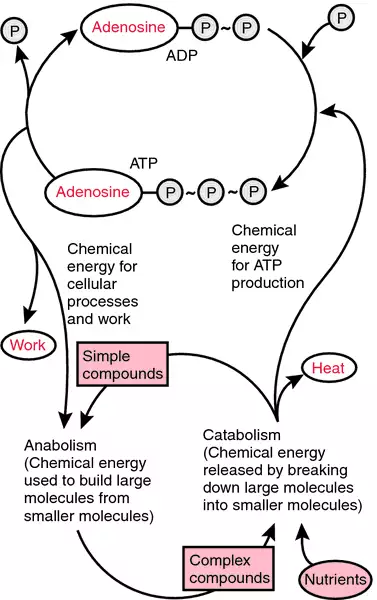Medical term:
ADP
adenosine
[ah-den´o-sēn]1. a nucleoside composed of the pentose sugar d-ribose and adenine. It is a structural subunit of ribonucleic acid (RNA). Adenosine nucleotides are involved in the energy metabolism of all cells. Adenosine can be linked to a chain of one, two, or three phosphate groups to form adenosine monophosphate (AMP), adenosine diphosphate (ADP), or adenosine triphosphate (ATP). The bond between the phosphate groups in ADP or the two bonds between phosphate groups in ATP are called high-energy bonds, because hydrolysis of a high-energy bond provides a large amount of free energy that can be used to drive other processes that would not otherwise occur. The energy that is derived from the breakdown of carbohydrates, fats, or proteins is used to synthesize ATP. The energy stored in ATP is then used directly or indirectly to drive all other cellular processes that require energy, of which there are four major types: (1) the transport of molecules and ions across cell membranes against concentration gradients, which maintains the internal environment of the cell and produces the membrane potential for the conduction of nerve impulses; (2) the contraction of muscle fibers and other fibers producing the motion of cells; (3) the synthesis of chemical compounds; (4) the synthesis of other high-energy compounds.

Adenosine.
2. a preparation of adenosine, which acts as a cardiac depressant of automaticity in the sinus node and conduction in the atrioventricular node and as a vasodilator. It is used as an antiarrhythmic and is also used to cause coronary vasodilation during myocardial perfusion imaging in patients who cannot exercise adequately to perform an exercise stress test, administered intravenously.
cyclic adenosine monophosphate a cyclic nucleotide, adenosine 3′,5′-cyclic monophosphate, involved in the action of many hormones, including catecholamines, ACTH, and vasopressin. The hormone binds to a specific receptor on the cell membrane of target cells. This activates an enzyme, adenylate cyclase, which produces cyclic AMP from ATP. Cyclic AMP acts as a second messenger activating other enzymes within the cell. Abbreviated 3′,5′-AMP, cAMP, and cyclic AMP.
adenosine diphosphate (ADP) a nucleotide, adenosine 5′-pyrophosphate, produced by the hydrolysis of adenosine triphosphate (ATP). It is then converted back to ATP by the metabolic processes oxidative phosphorylation, glycolysis, and the tricarboxylic acid cycle.
adenosine monophosphate (AMP) a nucleotide, adenosine 5′-phosphate, involved in energy metabolism and nucleotide synthesis. Called also adenylic acid.
adenosine triphosphatase (ATPase) a term used to refer to the enzymatic activity of certain intercellular processes that split ATP to form ADP and inorganic phosphate, when the energy released is not used for the synthesis of chemical compounds. Examples are the splitting of ATP in muscle contraction and the transport of ions across cell membranes.
adenosine triphosphate (ATP) a nucleotide, adenosine 5′-triphosphate, occurring in all cells, where it stores energy in the form of high-energy phosphate bonds. Free energy is supplied to drive metabolic reactions, to transport molecules against concentration gradients (active transport), and to produce mechanical motion (contraction of myofibrils and microtubules), when ATP is hydrolyzed to ADP and inorganic phosphate or to AMP and inorganic pyrophosphate. ATP is also used to produce high-energy phosphorylated intermediary metabolites, such as glucose 6-phosphate.
Miller-Keane Encyclopedia and Dictionary of Medicine, Nursing, and Allied Health, Seventh Edition. © 2003 by Saunders, an imprint of Elsevier, Inc. All rights reserved.
ADP
Abbreviation for adenosine 5'-diphosphate.
Farlex Partner Medical Dictionary © Farlex 2012
ADP
(ā′dē′pē′)n.
A nucleotide, C10H15N5O10P2, that is composed of adenosine and two linked phosphate groups, and that is converted to ATP for the storage of energy in living cells.
The American Heritage® Medical Dictionary Copyright © 2007, 2004 by Houghton Mifflin Company. Published by Houghton Mifflin Company. All rights reserved.
ADP
Abbreviation for:adenosine diphosphate, see there
adductor pollicis
advance planning document
after depolarising potential
Animal Disease & Parasite Research Division (of the USDA)
aortic diastolic pressure
approved drug product
assistant director of pathology (Medspeak-UK)
Association for Disabled Professionals
automatic data processing, see there (Medspeak-UK)
Segen's Medical Dictionary. © 2012 Farlex, Inc. All rights reserved.
ADP
Abbreviation for adenosine 5'-diphosphate.
Medical Dictionary for the Health Professions and Nursing © Farlex 2012
ADP
Adenosine diphosphate. See ADENOSINE TRIPHOSPHATE.Collins Dictionary of Medicine © Robert M. Youngson 2004, 2005

Fig. 15 ADP . General structure of ADP and ATP. P = phosphate group.
ADP (adenosine diphosphate)
a molecule consisting of an ADENOSINE unit on to which are attached two phosphate groups, which are joined by a high-energy bond. ADP can be converted to ATP by the addition of inorganic phosphate and about 34 kJ energy. See Fig. 15 . See ATP for molecular structure.Collins Dictionary of Biology, 3rd ed. © W. G. Hale, V. A. Saunders, J. P. Margham 2005
Word not found in the Dictionary and Encyclopedia. Did you mean:
- Advene
- Alphen
- Audiphone
- Ativan
- Idiophon
- Autophony
Latest Searches:
actinomycomata - acthib - acrospire - acrosin - acroscleroderma - acromiothoracic - acromioplasty - acrobystiolith - acrisorcin - AcQtrack - acorea - acoflex - acochoerus - acidogenic - acidity - acidimetries - acidimeter - achillotenotomy - achillodynia - acetylization -
- Service manuals - MBI Corp